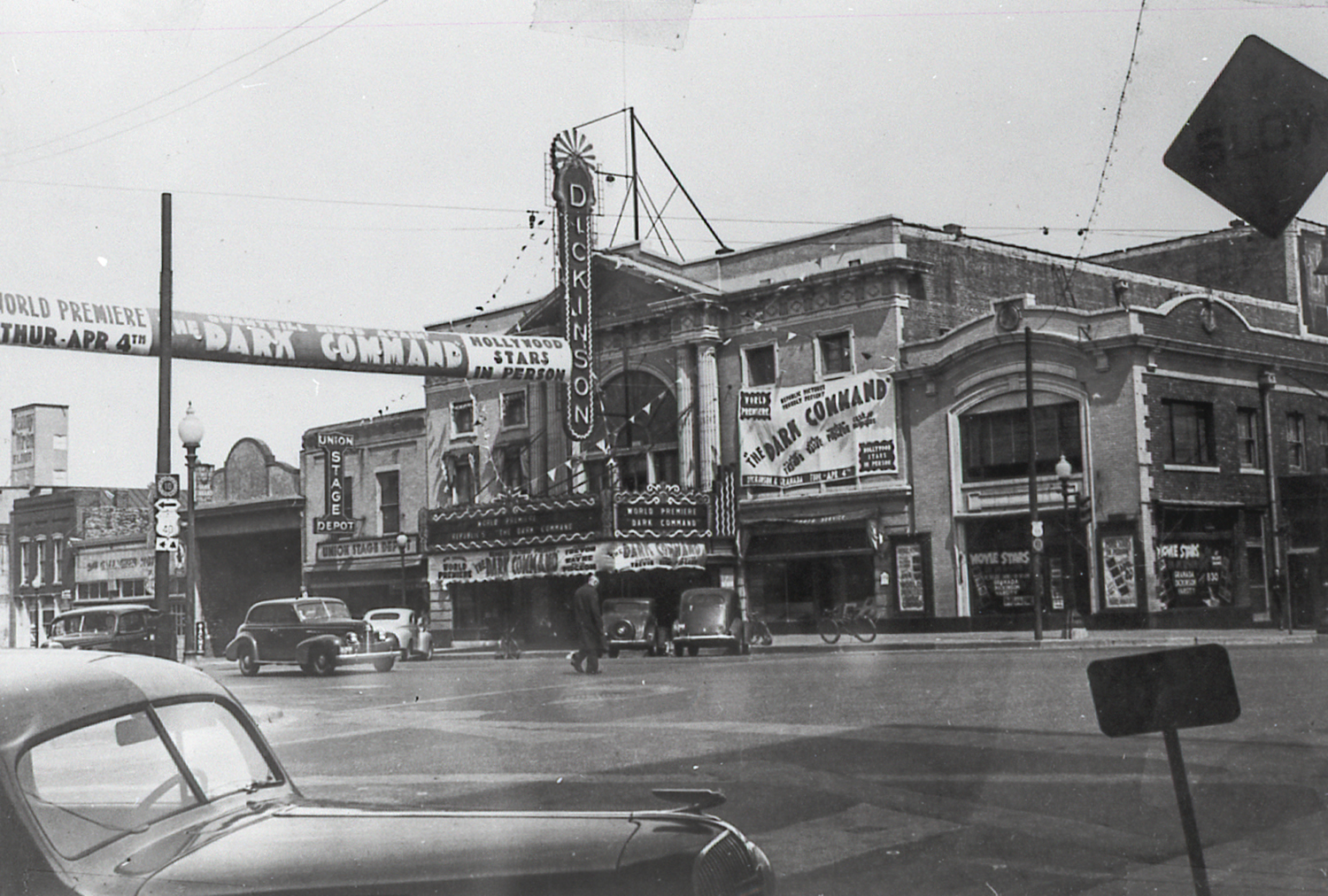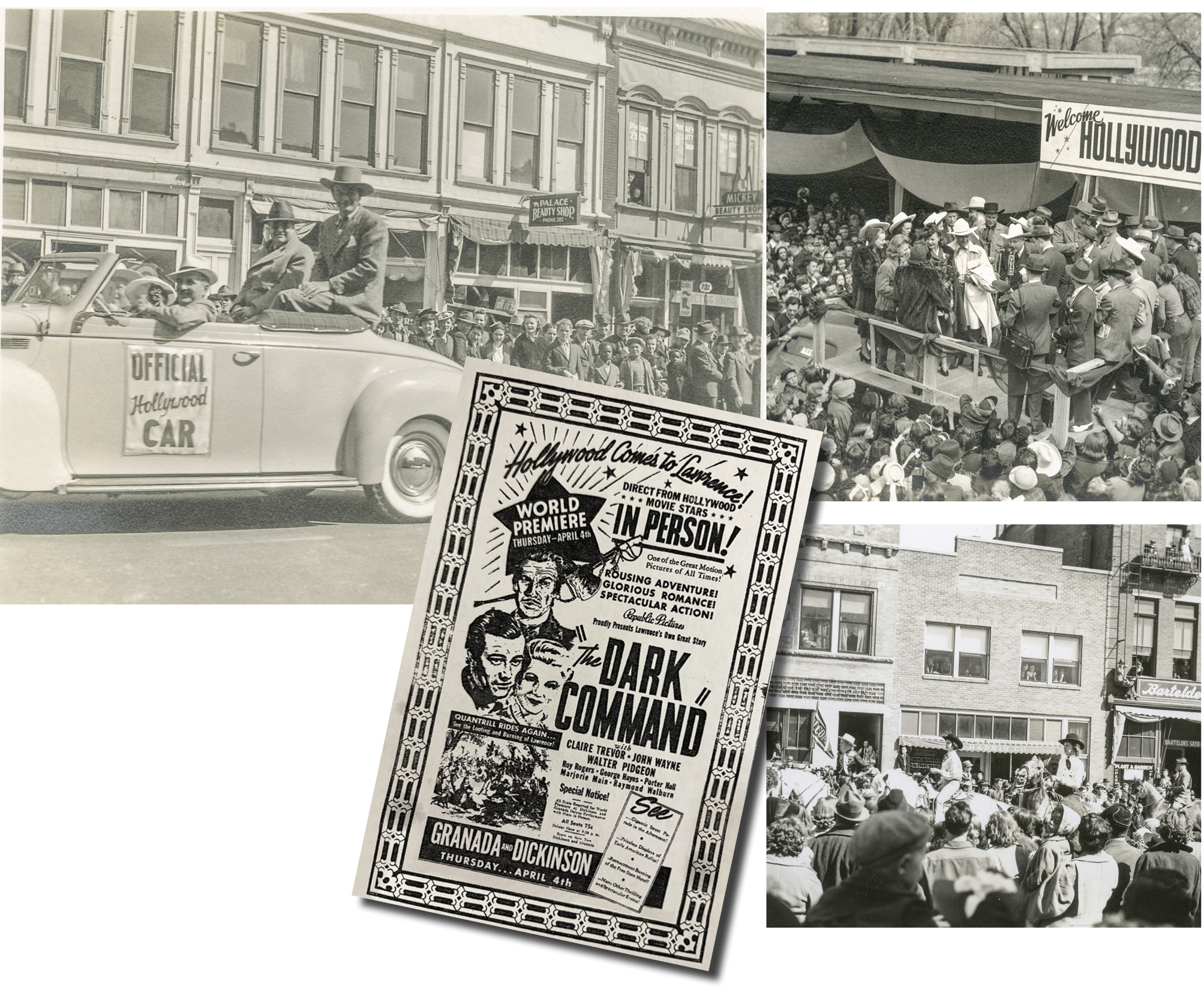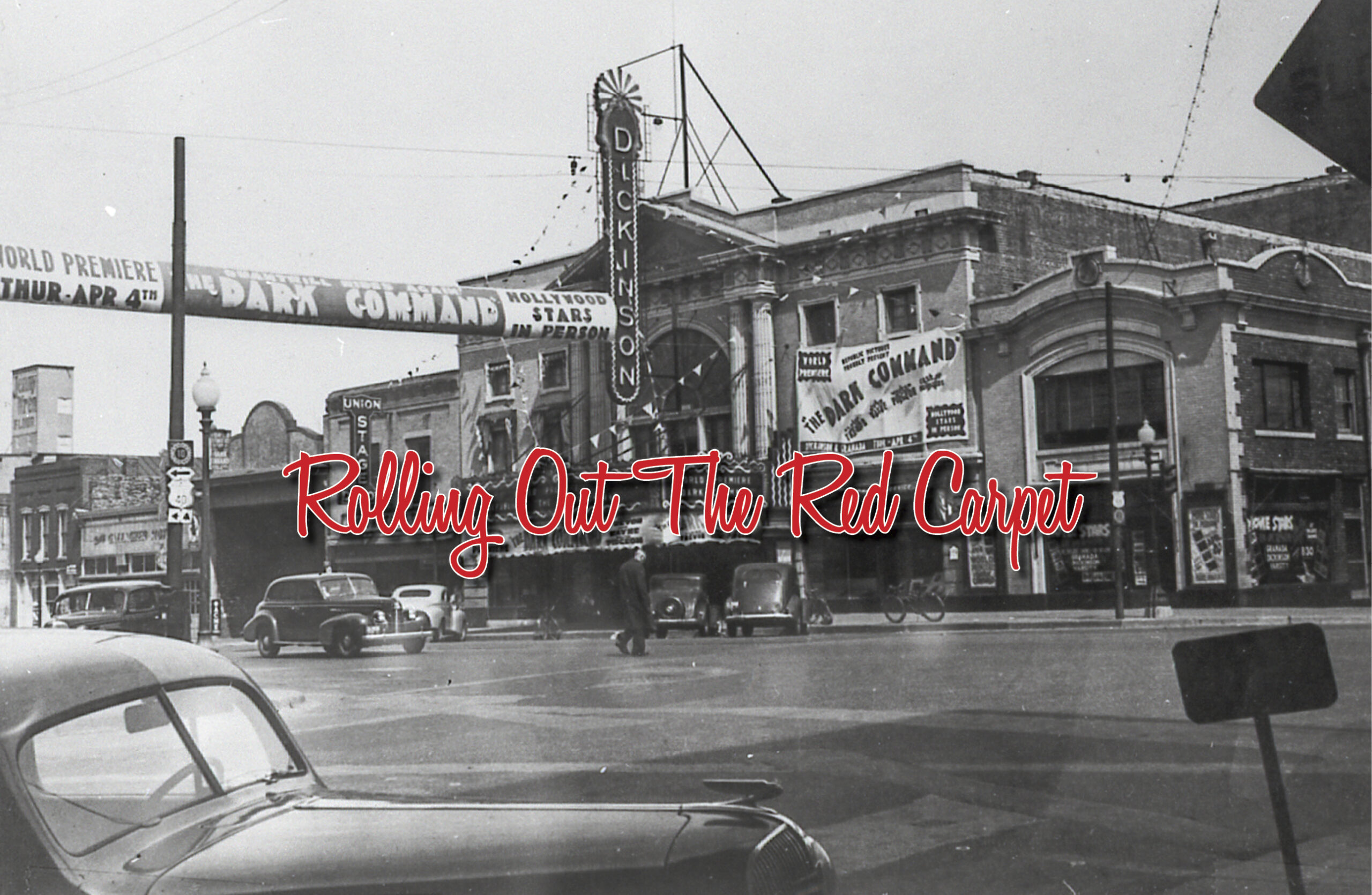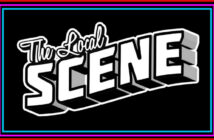| story by | |
| photos | Douglas County Historical Society, Watkins Museum of History |
| OPEN A PDF OF THE ARTICLE |
The Lawrence community in 1940 welcomed with open arms legends like John Wayne and Gene Autry at the world premiere of their movie based on Quantrill’s Raid.

“Dark Command” premiere at Dickinson Theater on Mass St. April 3, 1940
“Hollywood Comes to Lawrence” was the title in the Lawrence Journal World advertisements promoting the world premiere of “Dark Command,” a movie loosely based on Quantrill’s Raid on Lawrence in 1863. The stars of the film, John Wayne, Walter Pidgeon, Gene Autry and others arrived in Lawrence on April 3, 1940, via the Atchison, Topeka and Santa Fe Railroad. It was estimated they were greeted by 15,000 fans at the railroad station, then moving to Massachusetts Street and taking over downtown. The Lawrence Journal World described the arrival as follows:
A gang of Hollywood celebrities, armed with only smiles and personality, raided Lawrence today, a far cry from the day 77 years ago when Quantrill and his mob swooped down on the city with their guns roaring. Instead of rifle and pistol shots, a Hollywood-staged aerial bombardment heralded the arrival of the five-car special train at the Santa Fe station. There were several differences in today’s raid from that of Quantrill—today’s was noisier, but not so bloody. In fact, the reddest thing about today’s raid were the lips and cheeks of the movie pretties who came for the world premiere of “Dark Command.” Obviously, the author of this article enjoyed the opportunity to write in a more expressive style rather than the more matter-of-fact journalistic style.
Lawrence schoolchildren were dismissed from school so they could participate in welcoming the movie stars. The Lawrence High School band was on a special platform, but their music was almost drowned out by the cheers of the fans. A Hollywood special effects man produced an aerial bombardment to add to the fanfare.
Gene Autry was the first to climb to the temporary stage. He waved his white cowboy hat. The newspaper described his outfit as “a heavy wool jacket with white, red and yellow stripes; a white shirt with two carnations embroidered on it; rust-colored trousers; and a pair of boots inlaid with various colors.” Each of the actors was introduced. Walter Pidgeon, wearing a blue chalk-striped suit, told the crowd: “Just because I played the part of Quantrill in the picture, I didn’t burn your city, so don’t handle me too roughly.” He was a favorite of the women in the crowd.
LOCAL MATTERS
Our Local Advertisers – Making a Positive Impact
Gabby Hayes, bewhiskered as always, commented: “This is more people than I ever saw before in one place and I’s sort of scared.” John Wayne, who played the part of the town marshal, was a fan favorite, and he signed autographs on hats, algebra books and pieces of paper. He even signed his name to a baby’s white shoe that had been handed to him by the baby’s mother.
The celebrities were greeted by the mayor of Lawrence and the president of the Chamber of Commerce. They spoke to the crowd over a public address system, and their comments were broadcast over WREN, a Topeka radio station. The actors were then transported to the Eldridge Hotel to wait until the parade. A list from the Eldridge House gave the room numbers for each of the celebrities, though the room numbers may have changed since 1940. The director of the movie, Raoul Walsh, was in Room 335. Gene Autry and his wife were in Rooms 322 and 324; and John Wayne was in Room 234. Walter Pidgeon, the best known of the actors, was in room 323.

The Duke” John Wayne riding in the parade for The Dark Command parade; Vintage poster for The Dark Command”; Lawrence welcomes Hollywood stars for “The Dark Command” premiere
A parade was scheduled for at 2 p.m. April 4 and started at Eleventh and Massachusetts streets. It was estimated that the parade would last for two hours. Gene Autry was the grand marshal, and his horse was decked out in a $2500 saddle, bridle and breast collar. Parade participants included 23 vehicles from the Cavalcade of American Transportation Museum at Fort Leavenworth, marching bands from The University of Kansas (KU), Haskell University and Lawrence senior and junior high schools. The 2-mile-long parade included 75 vehicles, 400 horses and approximately 750 people in period costumes. KU Chancellor D. W. Malott and Lawrence mayor C. B. Russell represented local officials. Walter Pidgeon was escorted by two KU coeds. Numerous styles of horse-drawn wagons, including a Conestoga pulled by a six-mule team, were featured in the parade, which concluded with 200 horses in lines of two and miniature Santa Fe and Union Pacific trains.
Following the parade, the burning of a replica of the Eldridge House occurred at South Park. More than 15,000 people viewed the blaze, created by Hollywood “Blondie” Anderson. Beams from large searchlights lit the park. The replica was destroyed by flames in just a few minutes. Many in the audience were startled by the intensity of the fire, which was over in 15 minutes. William Saal, a special representative of Republic Studios, which created “Dark Command,” introduced the stars of the movie from the balcony of the replica Eldridge House. A pageant was part of the festivities, and a narrator described the events of the raid. He told of a small band of defenders camped at the edge of Lawrence and of the arrival of the raiders galloping from the east. After a shot was fired, the raiders entered the park. As the reenactor playing Quantrill rode up to the Eldridge House, he ordered the stripping of jewels and other valuables from the guests. The “guerrillas” set fire to the hotel, and the heat from the fire caused some of the “dead” defenders to move away from the scene. The crowd then headed to The Granada and Dickinson Theatres to view the premiere of the film, the reason for all of the excitement in Lawrence that day.
In an additional effort to promote the film and Republic Studios, Gene Autry visited the junior and senior high schools. About 300 junior high students filled the auditorium to hear Autry sing, and one of their own students served as his accompanist. The same occurred at the high school where Autry sang, accompanied by a local student.
Autry described the process of making musical westerns to the students. He wore his iconic white cowboy hat, blue trousers and brightly colored boots and jacket. He told his young audiences that the men riding horseback in these movies was not fake. Roads or a track on the movie set were graded, and oil or water was used to keep down the dust. He explained that a camera car followed beside the riders and filmed the action. He said his horse had been clocked at 40 to 45 miles per hour.
Autry stayed in Lawrence an extra day to promote his latest movie, “Rancho Grande,” and met with fans on The Granada stage during the Friday matinee and the evening showing. Autry placed an ad in the Lawrence Journal World stating he “would like to meet each and everyone of you while I’m at The Granada, and I hope that you will bring the kiddies.”
Lawrence reacted to the world premiere of “Dark Command” with enthusiasm. Thousands met the special Santa Fe train that brought the actors to Lawrence. Autograph seekers filled the streets. The city rolled out the “red carpet” with a two-hour parade in its honor. This world premiere was one of the community highlights of 1940.




